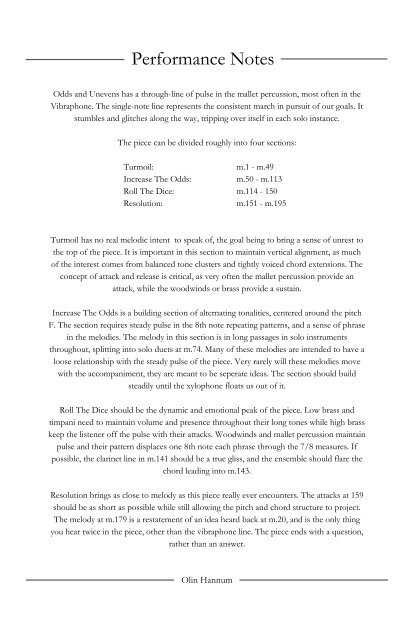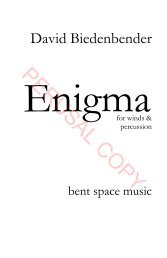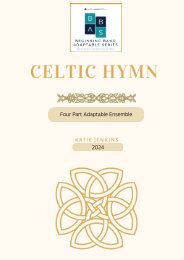Create successful ePaper yourself
Turn your PDF publications into a flip-book with our unique Google optimized e-Paper software.
Performance Notes<br />
<strong>Odds</strong> <strong>and</strong> <strong>Unevens</strong> has a through-line of pulse in the mallet percussion, most often in the<br />
Vibraphone. The single-note line represents the consistent march in pursuit of our goals. It<br />
stumbles <strong>and</strong> glitches along the way, tripping over itself in each solo instance.<br />
The piece can be divided roughly into four sections:<br />
Turmoil: m.1 - m.49<br />
Increase The <strong>Odds</strong>: m.50 - m.113<br />
Roll The Dice: m.114 - 150<br />
Resolution: m.151 - m.195<br />
Turmoil has no real melodic intent to speak of, the goal being to bring a sense of unrest to<br />
the top of the piece. It is important in this section to maintain vertical alignment, as much<br />
of the interest comes from balanced tone clusters <strong>and</strong> tightly voiced chord extensions. The<br />
concept of attack <strong>and</strong> release is critical, as very often the mallet percussion provide an<br />
attack, while the woodwinds or brass provide a sustain.<br />
Increase The <strong>Odds</strong> is a building section of alternating tonalities, centered around the pitch<br />
F. The section requires steady pulse in the 8th note repeating patterns, <strong>and</strong> a sense of phrase<br />
in the melodies. The melody in this section is in long passages in solo instruments<br />
throughout, splitting into solo duets at m.74. Many of these melodies are intended to have a<br />
loose relationship with the steady pulse of the piece. Very rarely will these melodies move<br />
with the accompaniment, they are meant to be seperate ideas. The section should build<br />
steadily until the xylophone floats us out of it.<br />
Roll The Dice should be the dynamic <strong>and</strong> emotional peak of the piece. Low brass <strong>and</strong><br />
timpani need to maintain volume <strong>and</strong> presence throughout their long tones while high brass<br />
keep the listener off the pulse with their attacks. Woodwinds <strong>and</strong> mallet percussion maintain<br />
pulse <strong>and</strong> their pattern displaces one 8th note each phrase through the 7/8 measures. If<br />
possible, the clarinet line in m.141 should be a true gliss, <strong>and</strong> the ensemble should flare the<br />
chord leading into m.143.<br />
Resolution brings as close to melody as this piece really ever encounters. The attacks at 159<br />
should be as short as possible while still allowing the pitch <strong>and</strong> chord structure to project.<br />
The melody at m.179 is a restatement of an idea heard back at m.20, <strong>and</strong> is the only thing<br />
you hear twice in the piece, other than the vibraphone line. The piece ends with a question,<br />
rather than an answer.<br />
Olin Hannum

















